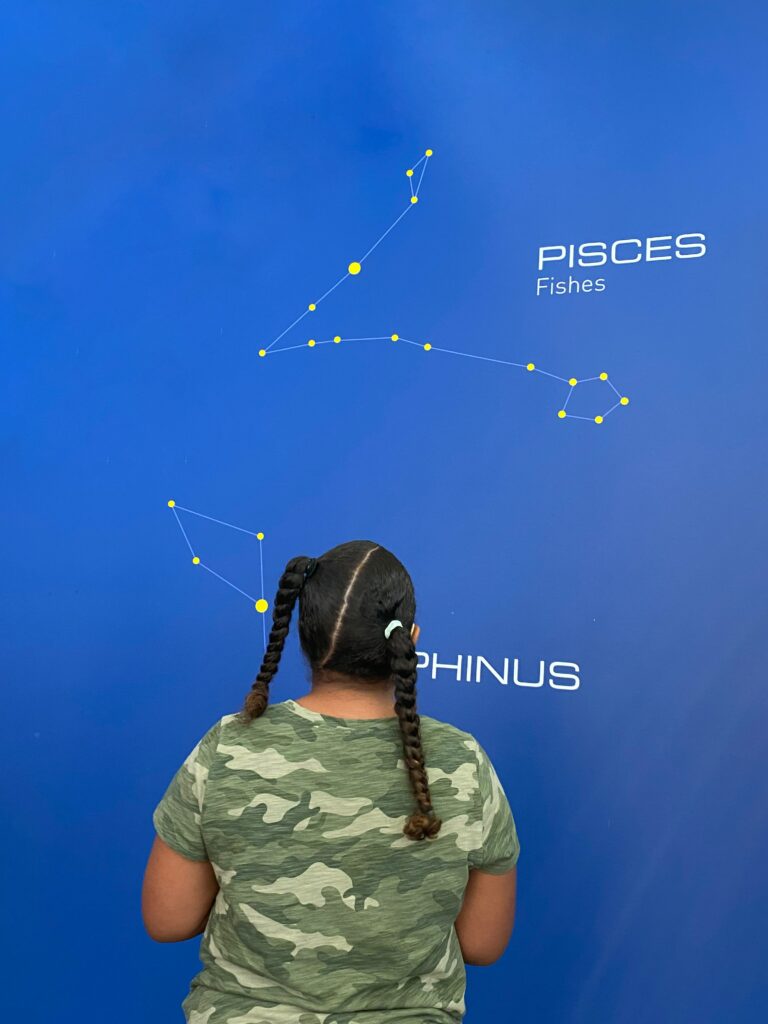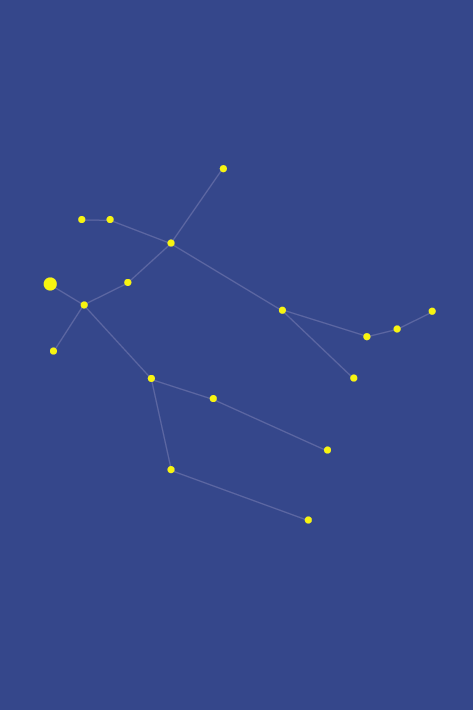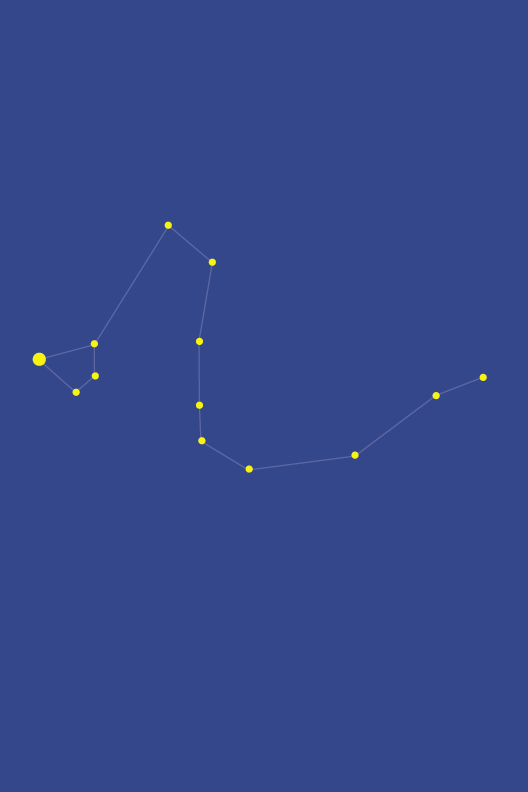People have always looked to the sky and found patterns in the stars. From spiritual to practical, stars aided navigation, timekeeping, and storytelling. Explore our new permanent exhibit, Patterns in the Sky, virtually and dive into the star stories and constellation mythologies from around the world.
About the Exhibit
The constellations referenced today stem from the discoveries of Greek and Roman culture.
An Ancient Greek text written by Ptolemy almost 2,000 years ago lists a group of about 48 formations. Later, between the 16th and 18th centuries, the advent of telescopes allowed us to find more constellations. Today, there are approximately 88 recognized constellations in the night sky.
Although constellations have largely outgrown their uses as navigation and time tools, they continue to serve as a link to the original people who looked to the sky and attempted to understand their universe.
In this exhibit, you will see a selection of constellations identified in the Western World and learn how different cultures interpreted the same stars across the globe.

Explore the constellations
Confederated Tribes of the Grand Ronde
Most Tribes in the Grand Ronde Community have an ikanum, or ancient story, about the Sun and Moon.
The Clackamas Chinook tells a story about a person who travels to the Sky World and marries the daughter of the Sun. When she comes to Earth, her two children become stars that can only be seen during certain times. An ikanum from the Tualatin Kalapuya tells of a boy who goes to the Moon and Sun seeking water, which he brings back to Earth.
Many Tribes see a human face in the Moon and tell stories of how the face appeared. The Tualatin Kalapuya ikanum talks of a misbehaving boy who was left outside when the Moon scooped him up. The child can be seen holding his bow at all times and is known as the boy who stands on the Moon.
The Clackamas and Shasta refer to multiple suns and moons. For the Shasta, each month brings a new and different moon.

Greek
The constellation Orion represents a hunter and includes a body that wields a sword or club. The Greeks tell a myth that Orion fell in love with the Pleiades, but when he pursued them, Zeus placed the sisters in the sky for protection. Orion can still be seen chasing the sisters across the night sky.
Ancient Egyptian
Ancient Egyptians associated the Orion constellation with Osiris, god of death, afterlife, and rebirth. The appearance of Osiris was connected to the rise and fall of the Nile River.
Aztec
The Aztecs coordinated the appearance of Orion’s Belt, which they called Fire Drill, with the New Fire Ceremony. This ritual allowed fires throughout the empire to be relit without angering the god of fire, Huehueteotl.
Tswana
Many other ancient cultures depicted animals in the stars of Orion’s Belt. The Tswana people of modern-day South Africa and Botswana called the constellation dintsa le Dikolobe, which means “The Three Dogs are Chasing the Three Pigs.” The three stars in the sword represent the dogs, while the stars of Orion’s Belt represent the pigs.

As it is the easiest star cluster to find in the night sky, cultures across the globe noticed the constellation Pleiades created their myths and stories on to it.
The Taurus constellation and Pleiades star cluster appear as early as 15,000 B.C., in cave paintings found in Lascaux Cave, France. In Greek mythology, the stars represent the Seven Sisters and their parents, Pleione and the Titan Atlas.
Australian Aboriginal
Aboriginals in Australia have a variety of names for the Seven Sisters. The group of stars is the Napaljarri sisters, and they are chased across land and sky by Jukurra-Jukurra or the Morning Star. As they travel through the sky to escape their lustful pursuer, they switch languages and become the Kungkarangkalpa. The sisters use their powers to move from the sky to humanoid form, known as Minyipuru. They also shape-shift into rocks, trees, and flowers and are ultimately successful in outwitting their antagonist.
Namaqua
The Namaqua people in Namibia tell a story of the daughters of the sky god. Their husband went hunting and shot his arrow at three zebras. When his shot fell short, the husband dared not return home because he had killed no game. He dared not retrieve his arrow because of a fierce lion that sat watching the zebras. He still sits in the sky, shivering and suffering from thirst and hunger.

Ursa Major is one of the most recognizable constellations in the night sky. It contains one of the most popular asterisms, the Big Dipper.
Greek
The Greek myth is a story of love and jealousy. Zeus fell in love with a nymph named Callisto. Angered by his wandering eye, Zeus’s wife Hera turned Callisto into a bear. Zeus carried Callisto and their son, Arcas, into the heavens to protect her from further harm.
Wasco
In a Wasco story, stars in the handle and bowl of the Big Dipper represent wolves and bears. One night the wolves went to the sky with a coyote in search of meat. The coyote and the wolves encountered grizzlies, and they just stared at each other. The coyote looked at the two groups and, liking what he saw, made them into a picture that the people on Earth could see.

Greek
In Greek mythology, Auriga connects to various stories. Some say the constellation represents Hephaestus, the god born with physical disabilities, who built the chariot to travel wherever or whenever he wanted without difficulty.
Hawaiian
In the Hawaiian wayfinding tradition, the same stars form the constellation Hoku-lei or Star-Wreath. The top point of Hoku-lei is the star that points north or ‘akau.

Greek
For the Greeks, these stars represent the brothers Castor and Pollux. When Castor perished in a fight for love, Pollux asked Zeus to share his immortality with his dead brother. Zeus placed them in the sky, where they remain inseparable.
Hindu
In the Hindu tradition, the constellation represents a pair of a different sort. Instead of brothers, Soma and Vishnu represent a story similar to Adam and Eve and suggest other important pairs such as Sun and Moon, day and night, heaven and Earth.

Greek
The Greek mythology surrounding the constellations Andromeda, Cassiopeia, Cepheus, and Perseus puts any soap opera to shame.
Queen Cassiopeia angered the sea nymphs when she boasted that she was more beautiful. The sea nymphs complained to Poseidon, who sent Cetus, a sea monster, to ravage her husband Cepheus’s kingdom. To end their suffering, Cassiopeia and Cepheus sacrificed their daughter Andromeda to Cetus. Perseus rescued Andromeda, and the two were married. But that wasn’t the end of it!
Amidst a duel between Andromeda’s other suitors, Perseus mistakenly killed Cassiopeia and Cepheus when he removed Medusa’s head.
The goddess Athena commemorated Andromeda by placing her image among the stars, next to the constellations representing her husband Perseus and mother Cassiopeia. Cassiopeia was condemned to circle the celestial pole forever and spends half the year upside down in the sky as punishment for her vanity. After his tragic death, Zeus placed Cepheus in the sky because he was descended from one of Zeus’ loves, the nymph Io.
Chinese
In Chinese astronomy, constellations are much smaller and more numerous than in Western traditions. Four mythological creatures guard the world called Four Symbols or Si Xiang.
The Four Symbols are the Azure Dragon, White Tiger, Black Tortoise, and Vermillion Bird. As the dragon is considered the noblest of animals, the Azure Dragon is the head of the four symbols. It is also the symbol of the emperor.
In Chinese mythology, the dragon is a fearsome and mighty creature. Unlike their Western counterparts, Chinese dragons are believed to be just, benevolent, and bringers of wealth and fortune.


